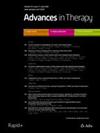估算美国成人中符合瑞美替罗治疗非肝硬化伴中晚期肝纤维化 NASH 的人群比例
摘要
导言:截至 2024 年 3 月,雷美替罗是美国批准的第一种也是唯一一种用于治疗非肝硬化性非酒精性脂肪性肝炎(NASH)且肝纤维化(MALF)达到 F2/F3 期的中晚期成人患者的疗法。由于诊断上的差异,人们对已确诊的、符合治疗条件的 NASH 患者的估计值知之甚少。本研究提供了对美国resmetirom治疗合格人群规模的当代估计。方法结合文献、筛查指南、resmetirom研究标准以及对NHANES 2017-2020年3月周期的分析,开发了一个动态人群计算器。它计算了 NASH 患病率、非肝硬化 NASH 与 MALF 的比例、第 1 年的诊断以及第 2 年和第 3 年的新诊断。NASH 患病率是通过应用美国临床内分泌协会筛查算法和 NHANES 数据集中推荐的 NIT 临界值估算得出的。使用 NASH 和肝硬化特异性 ICD-10-CM 代码和 FIB-4 评分对 Forian 美国综合医疗索赔数据库进行分析后,得出了非肝硬化 NASH 与 MALF 的比例。NASH 诊断率来自于已公布的估计值和 NHANES 反应。根据已公布的发病率数据预测符合治疗条件的人口增长情况。结果在基础病例中,NASH 患病率为 4.6%(范围为 1.3-14.2%)。该数值乘以非肝硬化 MALF 的估计比例(即 35%)。已公布的分析表明,诊断率约为 10%(范围为 3.3-14.3%),符合治疗条件的人群每年增长约 16%。假设商业成员人口为 100 万,那么在批准后的第 1-3 年,符合瑞美替罗治疗条件的人口估计为 1255-1699 人。进行了敏感性分析,与 ICER BIA 的比较受到不同诊断率的影响。结论resmetirom 治疗合格人群的估计在很大程度上取决于 NASH 诊断率,据预测,在药物批准后的 3 年内,NASH 诊断率为 <15%。以前美国没有治疗 NASH 的药物,但截至 2024 年 3 月,美国食品和药物管理局(FDA)批准了雷美替罗 (REZDIFFRA™),这是一种每日一次的口服疗法,与饮食和运动相结合,加速批准用于治疗患有中晚期肝纤维化 (MALF) 的非肝硬化 NASH 成人(18 岁或以上),符合 F2-F3 期。目前尚不清楚有多少确诊的 NASH 患者符合接受瑞美替罗治疗的条件;因此,本研究旨在估算美国符合瑞美替罗治疗条件的人群规模。为此,我们创建了一个灵活的人群计算器,该计算器考虑了有多少人患有 NASH,有多大比例的人符合瑞美替罗治疗条件(即患有非肝硬化性 NASH 并伴有 MALF),以及其中有多少人会被确诊。我们利用已发表的文献、筛查指南、瑞美替罗研究标准以及全国性调查分析来确定估算范围。在主要分析中,我们模拟的 NASH 患病率为 4.6%(范围为 1.3-14.2%),然后将其限制在估计患有非肝硬化性 NASH 并伴有 MALF 的比例(即 35%)和确诊比例(即 10%,范围为 3.3-14.3%)。在批准后的几年中,符合治疗条件的人群每年增长约 16%。假设有 100 万商业保险参保者,那么在批准后的第 1-3 年,符合瑞美替罗治疗条件的人群估计为 1255-1699 人。我们评估了其他方案,并将结果与现有模型进行了比较。

Introduction
As of March 2024, resmetirom is the first and only therapy approved in the United States (US) for the treatment of adults with non-cirrhotic nonalcoholic steatohepatitis (NASH) with moderate-to-advanced liver fibrosis (MALF) consistent with stages F2/F3 fibrosis. Estimates of the diagnosed, treatment-eligible NASH population are poorly understood due to diagnostic variability. This study provides a contemporary estimate of the size of the US resmetirom treatment-eligible population.
Methods
A dynamic population calculator was developed combining literature, screening guidelines, resmetirom study criteria, and analyses of the NHANES 2017–March 2020 cycle. It computes NASH prevalence, proportion non-cirrhotic NASH with MALF, Year 1 diagnosis, and new diagnoses in Years 2 and 3. NASH prevalence was estimated by applying the American Association of Clinical Endocrinology screening algorithm and recommended NIT cut-offs in the NHANES dataset. The proportion of non-cirrhotic NASH with MALF was informed by analyses of the Forian US integrated medical claims database using NASH and cirrhosis-specific ICD-10-CM codes and FIB-4 scores. NASH diagnosis rates were obtained from published estimates and NHANES responses. Treatment-eligible population growth was projected using published incidence data. Estimates were compared to a NASH budget-impact-analysis (BIA) from the Institute for Clinical and Economic Review (ICER).
Results
In the base case, a NASH prevalence of 4.6% was modeled (range 1.3–14.2%). This value was multiplied by the proportion estimated to have non-cirrhotic MALF (i.e., 35%). Published analyses suggest a diagnosis rate of ~ 10% (range 3.3–14.3%) and ~ 16% year-over-year growth in the treatment-eligible population. Assuming a 1-million commercial-member population, the resmetirom treatment-eligible population was estimated as 1255–1699 in Years 1–3 following approval. Sensitivity analyses were conducted and comparison to the ICER BIA was influenced by different diagnosis rates.
Conclusion
Estimation of the treatment-eligible population for resmetirom depends importantly on NASH diagnosis rates, which are predicted to be < 15% in the 3 years after drug approval.
Plain Language Summary
Nonalcoholic steatohepatitis (NASH) is an advanced form of nonalcoholic fatty liver disease. Previously there were no treatments for NASH in the United States (US), but as of March 2024, the US Food and Drug Administration (FDA) approved resmetirom (REZDIFFRA™), a once-daily, oral therapy, in conjunction with diet and exercise, under accelerated approval for the treatment of adults (aged 18 years or older) with non-cirrhotic NASH with moderate-to-advanced liver fibrosis (MALF), consistent with stages F2–F3. It is not well understood how many diagnosed patients with NASH would be eligible for treatment with resmetirom; thus, this study aimed to estimate the size of the US resmetirom treatment-eligible population. To do so, we created a flexible population calculator that considers how many people have NASH, what proportion would be eligible for resmetirom treatment—i.e., have non-cirrhotic NASH with MALF—and of those how many people would be diagnosed. We used published literature, screening guidelines, resmetirom study criteria, and analyses of national surveys to inform our range of estimates. In the main analysis, we modeled a NASH prevalence of 4.6% (range 1.3–14.2%), which was then limited to the proportion estimated to have non-cirrhotic NASH with MALF (i.e., 35%) and diagnosed (i.e., 10%, range 3.3–14.3%). A year-over-year growth of approximately 16% in the treatment-eligible population was modeled in years following approval. Assuming a population of 1 million commercial insurance enrollees, the resmetirom treatment-eligible population was estimated to be 1255–1699 in Years 1–3 following approval. We assessed alternative scenarios and have compared our results to existing models.

 求助内容:
求助内容: 应助结果提醒方式:
应助结果提醒方式:


